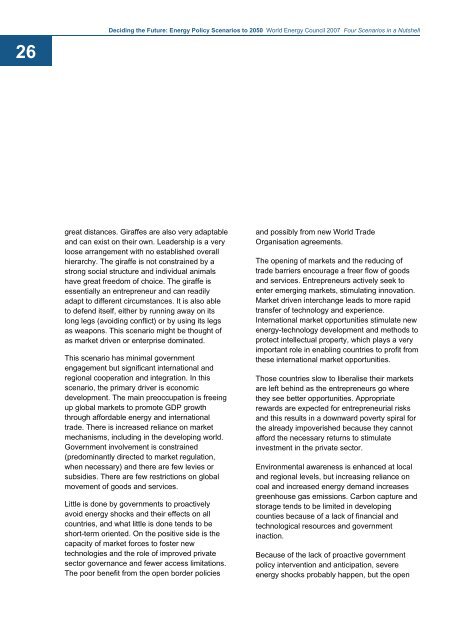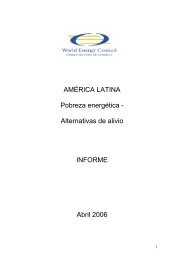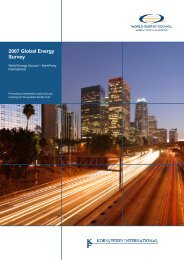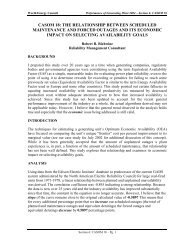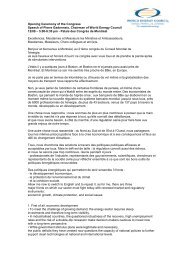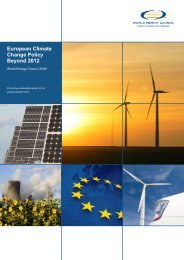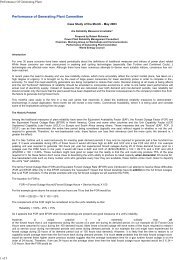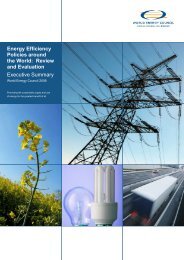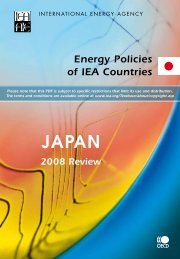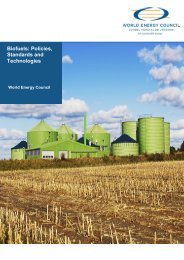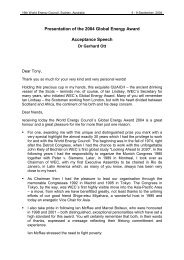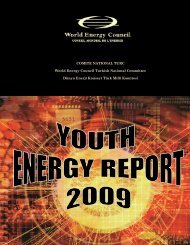Deciding the Future: Energy Policy Scenarios to 2050
Deciding the Future: Energy Policy Scenarios to 2050
Deciding the Future: Energy Policy Scenarios to 2050
You also want an ePaper? Increase the reach of your titles
YUMPU automatically turns print PDFs into web optimized ePapers that Google loves.
26<br />
<strong>Deciding</strong> <strong>the</strong> <strong>Future</strong>: <strong>Energy</strong> <strong>Policy</strong> <strong>Scenarios</strong> <strong>to</strong> <strong>2050</strong> World <strong>Energy</strong> Council 2007 Four <strong>Scenarios</strong> in a Nutshell<br />
great distances. Giraffes are also very adaptable<br />
and can exist on <strong>the</strong>ir own. Leadership is a very<br />
loose arrangement with no established overall<br />
hierarchy. The giraffe is not constrained by a<br />
strong social structure and individual animals<br />
have great freedom of choice. The giraffe is<br />
essentially an entrepreneur and can readily<br />
adapt <strong>to</strong> different circumstances. It is also able<br />
<strong>to</strong> defend itself, ei<strong>the</strong>r by running away on its<br />
long legs (avoiding conflict) or by using its legs<br />
as weapons. This scenario might be thought of<br />
as market driven or enterprise dominated.<br />
This scenario has minimal government<br />
engagement but significant international and<br />
regional cooperation and integration. In this<br />
scenario, <strong>the</strong> primary driver is economic<br />
development. The main preoccupation is freeing<br />
up global markets <strong>to</strong> promote GDP growth<br />
through affordable energy and international<br />
trade. There is increased reliance on market<br />
mechanisms, including in <strong>the</strong> developing world.<br />
Government involvement is constrained<br />
(predominantly directed <strong>to</strong> market regulation,<br />
when necessary) and <strong>the</strong>re are few levies or<br />
subsidies. There are few restrictions on global<br />
movement of goods and services.<br />
Little is done by governments <strong>to</strong> proactively<br />
avoid energy shocks and <strong>the</strong>ir effects on all<br />
countries, and what little is done tends <strong>to</strong> be<br />
short-term oriented. On <strong>the</strong> positive side is <strong>the</strong><br />
capacity of market forces <strong>to</strong> foster new<br />
technologies and <strong>the</strong> role of improved private<br />
sec<strong>to</strong>r governance and fewer access limitations.<br />
The poor benefit from <strong>the</strong> open border policies<br />
and possibly from new World Trade<br />
Organisation agreements.<br />
The opening of markets and <strong>the</strong> reducing of<br />
trade barriers encourage a freer flow of goods<br />
and services. Entrepreneurs actively seek <strong>to</strong><br />
enter emerging markets, stimulating innovation.<br />
Market driven interchange leads <strong>to</strong> more rapid<br />
transfer of technology and experience.<br />
International market opportunities stimulate new<br />
energy-technology development and methods <strong>to</strong><br />
protect intellectual property, which plays a very<br />
important role in enabling countries <strong>to</strong> profit from<br />
<strong>the</strong>se international market opportunities.<br />
Those countries slow <strong>to</strong> liberalise <strong>the</strong>ir markets<br />
are left behind as <strong>the</strong> entrepreneurs go where<br />
<strong>the</strong>y see better opportunities. Appropriate<br />
rewards are expected for entrepreneurial risks<br />
and this results in a downward poverty spiral for<br />
<strong>the</strong> already impoverished because <strong>the</strong>y cannot<br />
afford <strong>the</strong> necessary returns <strong>to</strong> stimulate<br />
investment in <strong>the</strong> private sec<strong>to</strong>r.<br />
Environmental awareness is enhanced at local<br />
and regional levels, but increasing reliance on<br />
coal and increased energy demand increases<br />
greenhouse gas emissions. Carbon capture and<br />
s<strong>to</strong>rage tends <strong>to</strong> be limited in developing<br />
counties because of a lack of financial and<br />
technological resources and government<br />
inaction.<br />
Because of <strong>the</strong> lack of proactive government<br />
policy intervention and anticipation, severe<br />
energy shocks probably happen, but <strong>the</strong> open


